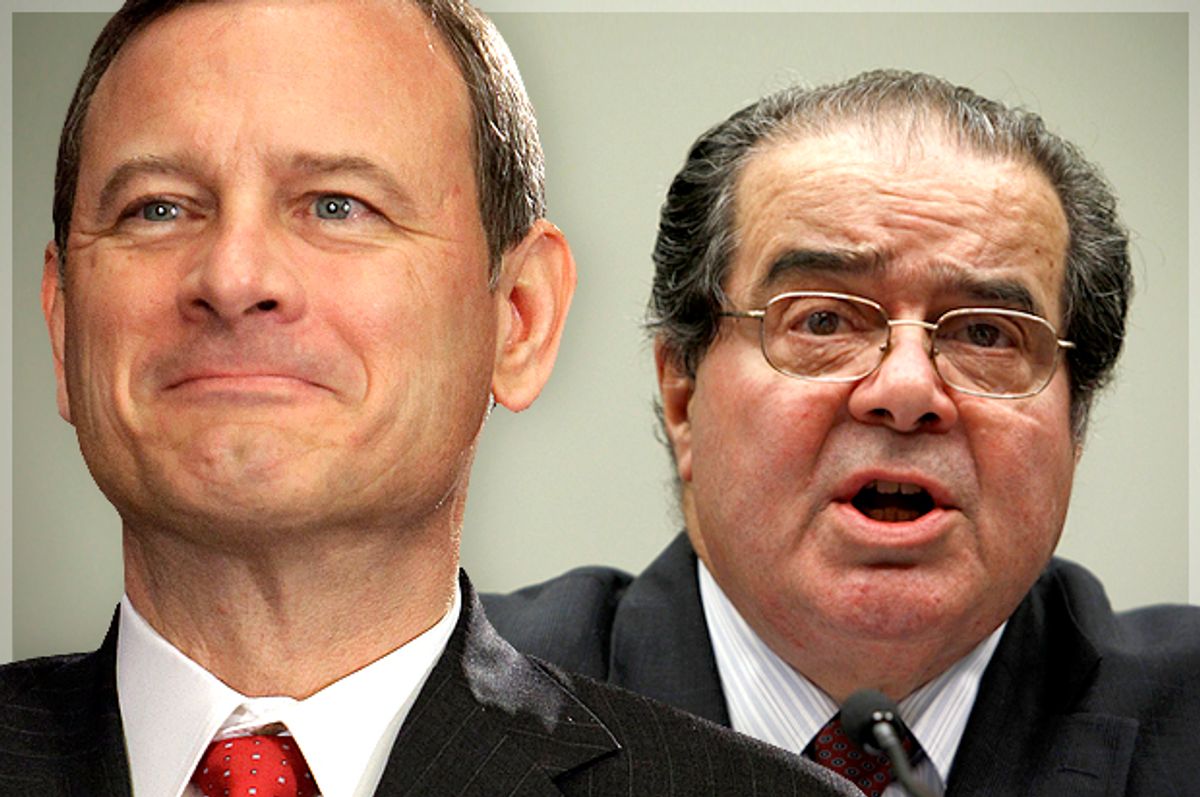It wasn’t quite March 6, 1857, or Dec. 12, 2000, but make no mistake: June 30, 2014, was not a good day for the U.S. Supreme Court. Not simply because it saw the court once again unveil two major decisions decided by a slim majority along partisan lines, but because the argument offered by the majority in the more controversial and closely followed of the two decisions was so conspicuously unprincipled that it will almost surely further erode public confidence in the nation’s highest court. As a Gallup poll also released Monday morning showed, it was already low; I bet it’s about to sink even lower.
In order to understand why Monday was such an important — and unfortunate — day for one of the United States’ most hallowed institutions, it’s necessary to revisit something Chief Justice John Roberts said in an interview way back in 2006. After crediting John Marshall’s legendary diplomatic skills for maintaining the unity and establishing the credibility of the court during its crucial early years, Roberts argued that, after 30-odd years of discord and squabbling, the Supreme Court was “ripe for a similar refocus on functioning as an institution” rather than as a collection of individuals with their separate politics, prejudices and philosophies. If the court failed to come together under his leadership, Roberts warned, it would “lose its credibility and legitimacy as an institution.”
Remember now, this was in 2006, when 5-4 splits on major, hot-button decisions was not yet the norm. This was before Parents Involved in Community Schools v. Seattle School District No. 1, before National Federation of Independent Business v. Sebelius, and before Citizens United v. Federal Election Commission, that ultimate embodiment of the partisan rancor and ideological polarization that’s so defined the Roberts-era court. It’s weird to think of the era of President Bush, Vice President Cheney and Senate Majority Leader Bill Frist as the good old days, but when it comes to the Supreme Court in the modern era, it more or less was.
Cut to today, and it’s hard to conclude that John Roberts is, by the standards he established in 2006, anything more than an abysmal failure. More than at any time since perhaps the Lochner Era, the court is not only seen as a political actor, but is considered a particularly ideological and combative one at that. Far from ushering in an era of good feelings, Roberts has presided over a court that is at war with itself, one in which justices like Antonin Scalia on the right, or Ruth Bader Ginsburg on the left, have become partisan heroes whose writings are studied not for their analytical insight but rather to see if they offer any good lines for use as weapons in the Internet’s endless partisan wars. And the public has noticed: In 2005, Gallup asked Americans how much confidence they had in the Supreme Court: 41 percent said “a great deal” or “quite a lot.” That number today? A paltry 30 percent.
It’s in this context that Monday’s two big rulings — Harris v. Quinn and Burwell v. Hobby Lobby Stores, Inc. — are most properly understood. While it’s true that many of the decisions handed down by the court this summer were unanimous, that harmony was never going to be enough to counterbalance the effects of the court’s two most closely watched decisions coming down, once again, as 5-4 splits. For one thing, the unanimous rulings Roberts engineered were far more internally divided than the 9-0 end results would lead you to think. For another, the public’s ability to follow or remember Supreme Court rulings is rather limited, which means that when it comes to public perception of the court, it’s the big deal decisions like Citizens United or Hobby Lobby that really count.
So when Justice Alito, who was the chief author of both of this term’s blockbuster decisions, relies on arguments as transparently political as those he wielded to decide Harris and Hobby Lobby, it makes Roberts’ work toward improving the court’s image that much harder. When Alito argues, as he does in Harris, that home-care workers paid by the state are not real public employees — not because of any intuitive distinction between your mother’s home-nurse and her bus driver, but because doing so is one of the easiest ways for him to rule against unions without taking the politically momentous step of nuking them entirely — it hurts the court. And when Alito echoes Bush v. Gore, as he does in Hobby Lobby, and states that the logic of the majority should not apply to medical services other than birth control — like vaccinations or blood transfusions — it hurts the court.
When John Roberts first assumed control of the Supreme Court, he spoke like a man who wanted to prove that the institution had earned its ostensible reputation as floating above politics and seeing beyond the tribal emotions of the culture war. But as the decisions on Monday showed, the reality is that the Roberts court is as political as ever. In Roberts' court, it’s not abstract ideas of justice and law and republican government that win the day — it’s corporations, religious conservatives, employers and anyone who worries first and foremost about the interests of the powerful and the elite. Unless John Roberts' goals were other than those he outlined in 2006, Monday's decisions can only be interpreted as yet another saddening defeat.



Shares